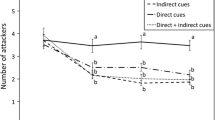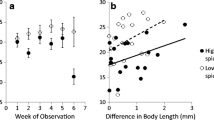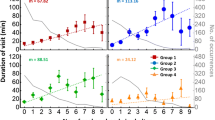Abstract
Animals living in social groups often need to conduct certain tasks, such as prey capture or nest maintenance. We might expect individuals to specialize in these tasks, as specialization should increase efficiency and therefore group performance. In groups that vary in sex, morphology, or generation, these factors often determine task participation. However, in social groups where these factors are invariant, persistent individual differences in behavior may drive task specialization. We tested this prediction in groups of the social spider Anelosimus eximius, through experiments conducted on natural colonies in the field. We measured the response to a risky stimulus of individual spiders and then tested whether this predicted their location and/or activity when placed back in a colony. We found the more risk-prone individuals were more likely to be in the more exposed areas of the colony used for capturing prey. Irrespective of the risk-taking behavior, individuals rest and care for young in the protective region of the colony, while in the exposed area of the web individuals are more active and more likely to be walking. Therefore, individual’s responses to risk showed an influence on where an individual would settle within the colony but had no effect on its activity. Our results support previous work that suggests adult A. eximius do not specialize in tasks. Indirect pathways for individual traits, via differences in spatial location or activity levels, may help to explain variation among-individuals in task participation.





Similar content being viewed by others
Data Availability
Data publicly available in a data repository: https://github.com/NuEVo-Ufba/Resende_etal_EximiusTask_R.git.
Code Availability
Code publicly available on Github repository: https://github.com/NuEVo-Ufba/Resende_etal_EximiusTask_R.git.
References
Agnarsson I, Zhang JX (2006) New species of Anelosimus (Araneae: Theridiidae) from Africa and Southeast Asia, with notes on sociality and color polymorphism. Zootaxa 1147:1. https://doi.org/10.11646/zootaxa.1147.1.1
Agnarsson I, Avilés L, Coddington JA, Maddison WP (2006) Sociality in theridiid spiders: repeated origins of an evolutionary dead end. Evolution 60:2342–2351. https://doi.org/10.1111/j.0014-3820.2006.tb01869.x
Agnarsson I, Coddington JA, Knoflach B (2007) Morphology and evolution of cobweb spider male genitalia (Araneae: Theridiidae). J Arachnol 35:334–395. https://doi.org/10.1636/SH-06-36.1
Altmann J (1974) Observational study of behavior: sampling methods. Behavior 49:227–267
Araújo MS, Bolnick DI, Layman CA (2011) The ecological causes of individual specialisation: the causes of individual specialisation. Ecol Lett 14:948–958. https://doi.org/10.1111/j.1461-0248.2011.01662.x
Avilés L (1997) Causes and consequences of cooperation and permanent-sociality in spiders. In: Choe JC, Crespi BJ (eds) The evolution of social behavior in insects and arachnids. Cambridge University Press, Cambridge, pp 476–498
Avilés L, Guevara J (2017) Sociality in spiders. In: Rubenstein DR, Abbot P (eds) Comparative social evolution. Cambridge University Press, Cambridge, pp 188–223
Bergmüller R, Taborsky M (2007) Adaptive behavioural syndromes due to strategic niche specialization. BMC Ecol 7:12. https://doi.org/10.1186/1472-6785-7-12
Bergmüller R, Taborsky M (2010) Animal personality due to social niche specialisation. Trends Ecol Evol 25:504–511. https://doi.org/10.1016/j.tree.2010.06.012
Biro PA, Stamps JA (2008) Are animal personality traits linked to life-history productivity? Trends Ecol Evol 23:361–368. https://doi.org/10.1016/j.tree.2008.04.003
Biro PA, Stamps JA (2010) Do consistent individual differences in metabolic rate promote consistent individual differences in behavior? Trends Ecol Evol 25:653–659. https://doi.org/10.1016/j.tree.2010.08.003
Boomsma JJ, Gawne R (2018) Superorganismality and caste differentiation as points of no return: how the major evolutionary transitions were lost in translation: superorganisms, eusociality and major transitions. Biol Rev 93:28–54. https://doi.org/10.1111/brv.12330
Brommer JE, Class B (2017) Phenotypic correlations capture between-individual correlations underlying behavioral syndromes. Behav Ecol Sociobiol 71:50. https://doi.org/10.1007/s00265-017-2278-4
Brooks ME, Kristensen K, van Benthem KJ, Magnusson A, Berg CW, Nielsen A et al (2017) Modeling zero-inflated count data with glmmTMB. bioRxiv 132753. https://doi.org/10.1101/132753
Careau V, Thomas D, Humphries MM, Réale D (2008) Energy metabolism and animal personality. Oikos 117:641–653. https://doi.org/10.1111/j.0030-1299.2008.16513.x
Dall SRX, Houston AI, McNamara JM (2004) The behavioural ecology of personality: consistent individual differences from an adaptive perspective. Ecol Lett 7:734–739. https://doi.org/10.1111/j.1461.0248.2004.00618.x
Dushoff J, Kain MP, Bolker BM (2019) I can see clearly now: reinterpreting statistical significance. Methods Ecol Evol 10:756–759. https://doi.org/10.1111/2041-210X.13159
Ebert D (1998) Behavioral asymmetry in relation to body weight and hunger in the tropical social spider Anelosimus eximius (Araneae: Theridiidae). J Arachnol 26:70–80
Fox J, Weisberg S (2019) An R companion to applied regression, 3rd edn. Sage, Thousand Oaks. https://socialsciences.mcmaster.ca/jfox/Books/Companion/. Accessed Oct 2021
Franks NR, Pratt SC, Mallon EB et al (2002) Information flow, opinion polling and collective intelligence in house–hunting social insects. Philos Trans R Soc Lond B Biol Sci 357:1567–1583. https://doi.org/10.1098/rstb.2002.1066
Gosling SD (2001) From mice to men: what can we learn about personality from animal research? Psychol Bull 127:45–86. https://doi.org/10.1037/0033-2909.127.1.45
Hartig F (2021) DHARMa: residual diagnostics for hierarchical (Multi-Level / Mixed) regression models. R package version 0.4.4. http://florianhartig.github.io/DHARMa/. Accessed Oct 2021
He P, Maldonado-Chaparro AA, Farine DR (2019) The role of habitat configuration in shaping social structure: a gap in studies of animal social complexity. Behav Ecol Sociobiol 73:9. https://doi.org/10.1007/s00265-018-2602-7
Japyassú HF, Malange J (2014) Plasticity, stereotypy, intra-individual variability andpersonality: handle with care. Behav Proc 109:40–47. https://doi.org/10.1016/j.beproc.2014.09.016
Johnson BR (2009) A self-organizing model for task allocation via frequent task quitting and random walks in the honeybee. Am Nat 174:537–547. https://doi.org/10.1086/605373
Koolhaas JM, de Boer SF, Coppens CM, Buwalda B (2010) Neuroendocrinology of coping styles: towards understanding the biology of individual variation. Front Neuroendocrinol 31:307–321. https://doi.org/10.1016/j.yfrne.2010.04.001
Krafft B, Cookson LJ (2012) The role of silk in the behaviour and sociality of spiders. Psyche J Entomol 2012:1–25. https://doi.org/10.1155/2012/529564
Levi HW (1963) The American spiders of the genus Anelosimus (Araneae: Theridiidae). Trans Am Microsc Soc 82:30. https://doi.org/10.2307/3223818
Lubin Y, Bilde T (2007) The evolution of sociality in spiders. Adv Stud Behav 37:83–145. https://doi.org/10.1016/S0065-3454(07)37003-4
Mersch DP, Crespi A, Keller L (2013) Tracking individuals shows spatial fidelity is a key regulator of ant social organization. Science 340:1090–1093. https://doi.org/10.1126/science.1234316
Montiglio PO, Ferrari C, Réale D (2013) Social niche specialization under constraints: personality, social interactions and environmental heterogeneity. Philos Trans R Soc B Biol Sci 368:20120343. https://doi.org/10.1098/rstb.2012.0343
Nakagawa S, Schielzeth H (2010) Repeatability for gaussian and non-gaussian data: a practical guide for biologists. Biol Rev 85:935–956. https://doi.org/10.1111/j.1469-185X.2010.000141.x
Oster GF, Wilson EO (1978) Caste and ecology in the social insects. Monogr Popul Biol 12:1–352
Pamminger T, Foitzik S, Kaufmann KC et al (2014) Worker personality and its association with spatially structured division of labor. PLoS ONE 9:e79616. https://doi.org/10.1371/journal.pone.0079616
Parthasarathy B, Joshi CH, Kalyadan SS, Somanathan H (2019) Early ontogenic emergence of personality and its long-term persistence in a social spider. Behav Ecol Sociobiol 73:35. https://doi.org/10.1007/s00265-019-2645-4
Pasquet A, Trabalon M, Bagnères AG, Leborgne R (1997) Does group closure exist in the social spider Anelosimus eximius ? Behavioural and chemical approach. Insec Soc 44:159–169. https://doi.org/10.1007/s000400050038
Pinter-Wollman N, Mi B, Pruitt JN (2017) Replacing bold individuals has a smaller impact on group performance than replacing shy individuals. Behav Ecol 28:883–889. https://doi.org/10.1093/beheco/arx054
Purcell J, Vasconcellos-Neto J, Gonzaga MO et al (2012) Spatio-temporal differentiation and sociality in spiders. PLoS ONE 7:e34592. https://doi.org/10.1371/journal.pone.0034592
R Core Team (2020) R: A language and environment for statistical computing. R Foundation for Statistical Computing, Vienna, Austria. https://www.R-project.org/. Accessed Oct 2021
Réale D, Dingemanse NJ (2010) Personality and individual social specialisation. In: Szekely T, Moore AJ, Komdeur J (eds) Social behaviour. Cambridge University Press, Cambridge, pp 417–441
Resende LPA, Rios VP, Japyassú HF (2019) The survival of the shyest: a computational model shows the effect of web structure on the origins of social spiders. AnBehav 155:229–239. https://doi.org/10.1016/j.anbehav.2019.05.029
Richardson TO, Christensen K, Franks NR et al (2011) Ants in a labyrinth: a statistical mechanics approach to the division of labour. PLoS ONE 6:e18416. https://doi.org/10.1371/journal.pone.0018416
Riechert SE, Hedrick AV (1993) A test for correlations among fitness-linked behavioural traits in the spider Agelenopsis aperta (Araneae: Agelenidae). Anim Behav 46:669–675. https://doi.org/10.1006/anbe.1993.1243
Schmid-Hempel P, Holldobler B, Wilson EO (1990) The ants. Springer, Berlin, 732 pp. DM 198.-. J Evol Biol 5:169–171. https://doi.org/10.1046/j.1420-9101.1992.5010169.x
Schwander T, Rosset H, Chapuisat M (2005) Division of labour and worker size polymorphism in ant colonies: the impact of social and genetic factors. Behav Ecol Sociobiol 59:215–221. https://doi.org/10.1007/s00265-005-0027-6
Schwander T, Lo N, Beekman M et al (2010) Nature versus nurture in social insect caste differentiation. Trends Ecol Evol 25:275–282. https://doi.org/10.1016/j.tree.2009.12.001
Seeley TD, Kolmes SA (2010) Age polyethism for hive duties in honey bees: illusion or reality? Ethology 87:284–297. https://doi.org/10.1111/j.1439-0310.1991.tb00253.x
Settepani V, Grinsted L, Granfeldt J et al (2013) Task specialization in two social spiders, Stegodyphus sarasinorum (Eresidae) and Anelosimus eximius (Theridiidae). J Evol Biol 26:51–62. https://doi.org/10.1111/jeb.12024
Sih A, Mathot KJ, Moíron M, Montiglio P, Wolf M, Dingemanse NJ (2014) Animal personality and state-behaviour feedbacks: a review and guide for empiricists. Trends Ecol Evol 30:50–60. https://doi.org/10.1016/j.tree.2014.11004
Silva LM, Batalha-Filho H, Japyassú HF, El-Hani CN (2020) Population history of a social spider reveals connection between south American tropical forests. Zool Anz 285:139–146. https://doi.org/10.1016/j.jcz.2020.01.004
Stamps J, Groothuis TGG (2010) The development of animal personality: relevance, concepts and perspectives. Biol Rev 85:301–325. https://doi.org/10.1111/j.1469-185X.2009.00103.x
Stoffel MA, Nakagawa S, Schielzeth H (2017) rptR: repeatability estimation and variance decomposition by generalized linear mixed-effects models. Methods Ecol Evol 8:1639–1644. https://doi.org/10.1111/2041-210X.12797
Theraulaz G, Bonabeau E, Denuebourg J-N (1998) Response threshold reinforcements and division of labour in insect societies. Proc R Soc Lond B Biol Sci 265:327–332. https://doi.org/10.1098/rspb.1998.0299
Vasconcellos-Neto J, Souza ALT, Marques ESA, Ferraz FFF (1995) Comportamento social de Anelosimus eximius (Theridiidae: Araneae). An de Etol 13:217–230
Venticinque EM, Fowler HG, Silva CA (1993) Modes and frequencies of colonization and its relation to extinctions, habitat and seasonality in the social spider Anelosimus eximius in the Amazon (Araneidae: Theridiidae). Psyche J Entomol 100:35–41. https://doi.org/10.1155/1993/82186
Wagner D, Tissot M, Gordon D (2001) Task-related environment alters the cuticular hydrocarbon composition of harvester ants. J Chem Ecol 27:1805–1819. https://doi.org/10.1023/A:1010408725464
Wallace B (1982) Phenotypic variation with respect to fitness: the basis for rank-order selection. Biol J Linn Soc 17:269–274. https://doi.org/10.1111/j.1095-8312.1982.tb02021.x
Ward AJW, Thomas P, Hart PJB, Krause J (2004) Correlates of boldness in three-spined sticklebacks (Gasterosteus aculeatus). Behav Ecol Sociobiol 55:561–568. https://doi.org/10.1007/s00265-003-0751-8
Wilson EO (1971) The prospects for a unified sociobiology: this important branch of behavioral biology should be joined with population biology. Am Sci 59:400–403
Wilson EO (1975) Some central problems of sociobiology. Soc Sci Inf 14:5–18. https://doi.org/10.1177/053901847501400601
Wilson EO, Hölldobler B (2005) Eusociality: origin and consequences. Proc Natl Acad Sci 102:13367–13371. https://doi.org/10.1073/pnas.0505858102
Acknowledgements
We thank Coordenação de Aperfeiçoamento de Pessoal de Nível Superior (CAPES) grant (nº 1583297) that supported this work. We also thank all Núcleo de Etologia e Evolução (NuEVo) colleagues that gave insights and precious suggestions to improve the work. We finally thank Rafael Paulino and Sidnei Sampaio for their help during field work.
Funding
This study was financed by Coordenação de Aperfeiçoamento de Pessoal de Nível Superior (CAPES) grant nº 1583297.
Author information
Authors and Affiliations
Contributions
Leonardo Palloni Accetti Resende collected the data, wrote the main manuscript text, and prepared Figs. 1 and 3. David Fisher performed the statistical analysis and prepared Figs. 2, 4, and 5. Isabelle Oliveira Lima Luz collected the data and contributed to the writing of the manuscript text. Hilton Ferreira Japyassú contributed to the writing of the manuscript text. All authors reviewed the manuscript.
Corresponding author
Ethics declarations
Ethics Approval
In Brazil there is no legislation that regulates the manipulation of invertebrate animal species for experimental studies.
Competing Interests
The authors declare no competing interests.
Additional information
Publisher’s Note
Springer Nature remains neutral with regard to jurisdictional claims in published maps and institutional affiliations.
Rights and permissions
Springer Nature or its licensor (e.g. a society or other partner) holds exclusive rights to this article under a publishing agreement with the author(s) or other rightsholder(s); author self-archiving of the accepted manuscript version of this article is solely governed by the terms of such publishing agreement and applicable law.
About this article
Cite this article
Resende, L.P.A., Fisher, D.N., Luz, I.O.L. et al. A Simpler Way to Organize Society: Response to a Risky Stimulus is Related to the Spatial Distribution of the Individuals Within a Spider Colonial Web. J Insect Behav (2024). https://doi.org/10.1007/s10905-024-09848-9
Received:
Revised:
Accepted:
Published:
DOI: https://doi.org/10.1007/s10905-024-09848-9




